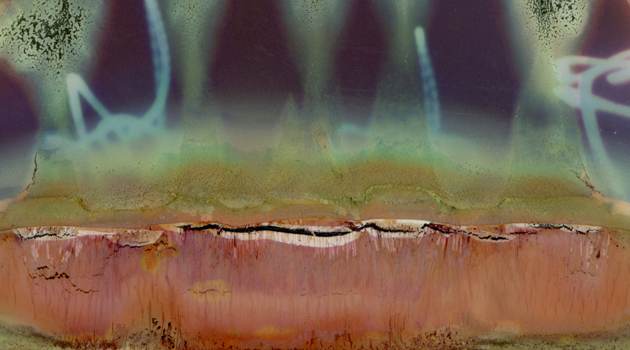Elegy to the Polaroid SX-70
Even abstract art must begin with something, Picasso said. A broken Polaroid camera, grinding film through its gears, yields a surprising amount of fleeting beauty.

Interview by Rosecrans Baldwin
The Morning News: Talk us through the series’ origin. What’s your history with Polaroid?
William Miller: The “Ruined Polaroid” series started by accident. I bought a used Polaroid SX-70 camera from a yard sale a few years ago. I’ve owned this camera several times before and I liked to use them to photograph abstract shapes as a respite from my day job as a photojournalist. Right away I could tell the camera was somewhat broken. It spit out two pictures at a time and there was something wrong with the rollers. The film was getting stuck in the gears, or the chemistry didn’t apply evenly to the image leaving some of it undeveloped. I put it down for a few months and tried again in the summer with the new Impossible Project film, which I was very excited about using. The camera had the same issues. I used wd-40 on the gears but this made it worse. The film was getting stuck in the camera and in some there was no discernable image. One day I was trying to “fix” the camera when I got a good look at all of the Polaroids that came out wrong. It occurred to me that they were actually pretty interesting, visually. I started running film through to see what else would happen. Over time I figured out how to control and accentuate aspects of the camera’s flaws, but the images themselves were always a surprise. Continue reading ↓
All images used with permission, copyright © the artist, all rights reserved.









Interview continued
TMN: What role does surprise play in your work?
WM: “Ruined Polaroids” was equal parts luck and perception. It started with me looking at about a dozen of these accidents and saying, “Is this something? Is this a thing?” Surprise is an important part of all of my work. I have specific ideas and approaches when I go into a project, but I hold them very, very loosely. When the unexpected does happen I try to be receptive, and that openness guides me.
TMN: What’s your favorite camera at the moment?
WM: At this very moment my favorite camera is a flatbed scanner. I don’t know if that’s considered a camera or a photographic appliance.
TMN: What’s your favorite household appliance?
WM: I have an ice cream machine I’m fond of. I like to make peculiar sorbets that no one wants to eat, such as wasabi cucumber, or avocado, or grilled peach with black pepper. Those flavors confuse people.
TMN: When was the last time you stood in front of a piece of art and felt confused?
WM: I’m confused a lot and invariably some of that confusion is going to occur while I’m standing in front of art. I can’t tell if that’s a reflection on the art.
TMN: Among the Polaroids, what makes a particular one a favorite?
WM: I think my favorite is Ruined Polaroid #45. It has all of the elements of this project that I found compelling including color, depth, and that texture that reminds me of a topographical map or an abstract expressionist painting. If the purpose of enlarging these little Polaroids to 30x36in was to get into the cracks of the chemistry and really take in its inherent physicality of Polaroid film, then #45 does that.
TMN: Favorite airport?
WM: My favorite airport would be any one that was converted to a rail station.
TMN: Karl Lagerfeld said, “What I like about photographs is that they capture a moment that’s gone forever, impossible to reproduce.”
WM: Photography is a lot like memory, which is to say it’s a very unreliable witness. Not the physical lenses and light of a camera (photography is good at depiction), but our relationship to images. I love photography but I definitely do not trust it at its word.
